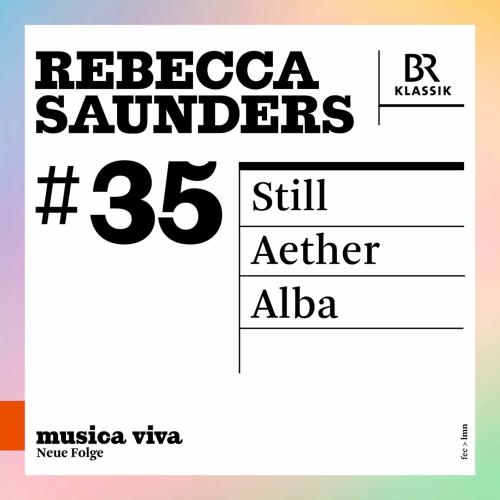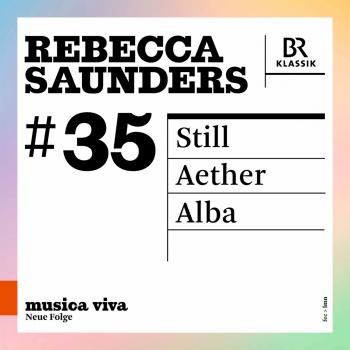
Album info
Album-Release:
2020
HRA-Release:
16.10.2020
Album including Album cover Booklet (PDF)
- Rebecca Saunders (b. 1967):
- 1 Violin Concerto "Still" (Live) 17:39
- 2 Aether (Live) 27:45
- 3 Trumpet Concerto "Alba" (Live) 21:30
Info for Musica viva, Vol. 35 (Live)
This portrait of the British composer Rebecca Saunders, who lives in Germany, includes her violin concerto "Still", the German premiere of the composition "Aether" for two bass clarinets and "Alba" for trumpet and orchestra. The Bavarian Radio Symphony Orchestra plays under the direction of Ilan Volkov and Peter Eötvös.
The portrait of Rebecca Saunders begins with her two-part violin concerto Still, written in 2011. It was premiered on September 29, 2011 at the Beethovenfest in Bonn. Carolin Widmann, who at the time was the first performer of the work, can also be heard as the violin soloist in this recording. The chamber music composition Aether for two bass clarinets was composed in 2015/16; its German premiere was recorded on December 15, 2017 in the Herkulessaal der Residenz in Munich. Finally, Alba for trumpet and orchestra came from a composition commission in 2014 by musica viva des Bayerischer Rundfunks and BBC Radio 3 for the BBC Scottish Symphony Orchestra. The premiere of the work, which is dedicated to the trumpeter Marco Blaauw, was recorded on February 20, 2015 in the Herkulessaal der Residenz in Munich.
Carolin Widmann, violin (Still)
Carl Rosman, bass clarinet(Aether)
Richard Haynes, bass clarinet (Aether)
Marco Blaauw, trumpet (Alba)
Symphonieorchester des Bayerischen Rundfunks
Ilan Volkov, direction
Peter Eötvös, direction
Founded by the German composer Karl Amadeus Hartmann in 1945 in Munich, musica viva is still one of the world’s most famous events for future-oriented and contemporary music, where many experimental works and performances for orchestra and chamber music receive their premiere.
The story of musica viva starts on October 7th, 1945 – a mere five months after the end of World War II.
A handful of curious music lovers gather at Prinzregententheater – even though there is no heating – to listen to Debussy, Busoni and Mahler – music that couldn’t be heard under the Nazi regime because the composers were banned. These concert series are founded by the German composer Karl Amadeus Hartmann. His goal is to introduce contemporary music to the audience.
But Hartmann faces problems financing his concerts. Locations change continuously. In 1948, Bayerischer Rundfunk or “Radio München” as it still was called back then – takes over sponsorship of musica viva. Not only does this give musica viva secure financing, Hartmann now also has a professional choir and orchestra at his disposal. In 1953, the Herkulessaal in the Munich Residency becomes musica viva’s permanent concert location.
PENT-UP DEMAND IN THE 1950s AND 60s
At first, Hartmann concentrates on showing his audience the developments in contemporary music that they had missed during twelve years of Nazi regime. Bit by bit he changes the programs’ focus to contemporary composition and world premieres. Quote: “The event’s duty is to provide the audience with an overview of the current intellectual and artistic development.” (Karl Amadeus Hartmann). Artists of international standing come to Munich: Stravinsky, Hindemith and Milhaud conduct concerts, aspiring young composers like Henze or Nono are presented. And to top it off, famous artists like Joan Miró design the title graphics for the concerts’ programs.
THE NEW FOCUS
In 1963, Karl Amadeus Hartmann dies. His successor, the composer Wolfgang Fortner, continues to lead musica viva in the same direction as Hartmann and does this together with Ernst Thomas. However, the concept isn’t working as smoothly anymore as it did a few years before. Ernst Thomas, being the former head of the Darmstädter Ferienkurse, brings more and more topics and themes from Darmstadt to Munich, such as discussions about music and language. These soon become the new focus at musica viva. In addition to that, they also start a series of experimental studio concerts.
In 1978, editor Jürgen Meyer-Josten, head of Bayerischer Rundfunk’s music department, takes over musica viva. For the first time, the concert series’ art director is a member of the Bayerischer Rundfunk. He broadens the spectrum of music that is played at the concerts.
Meyer-Josten is later succeeded by Udo Zimmermann in 1997 and once again a composer runs musica viva. Zimmermann is aided by Josef Anton Riedl and Winrich Hopp. Together they bring new dynamics to the musica viva concerts by contracting young composers. Their program includes works by Stockhausen, Xenakis and Schnebel as well as experimental special events and studio concerts.
Winrich Hopp, who took over musica viva in 2011, didn’t only stick to this new concept but also expanded it. He conducts big projects like Stockhausen’s “Samstag aus Licht” (Saturday from Light) and connects musica viva with European event organizers. He also involves the Symphonieorchester des Bayerischen Rundfunks (BRSO) in musica viva concerts by including musicians when choosing different chamber formations. musica viva has changed considerably since its beginnings in 1945 – but it’s still as alive and future-oriented as it was when Hartmann started it.
Booklet for Musica viva, Vol. 35 (Live)










